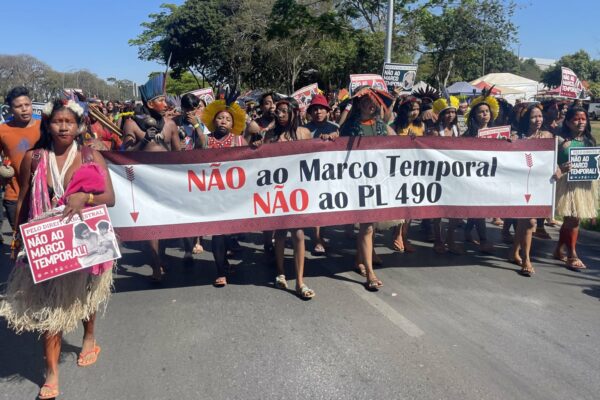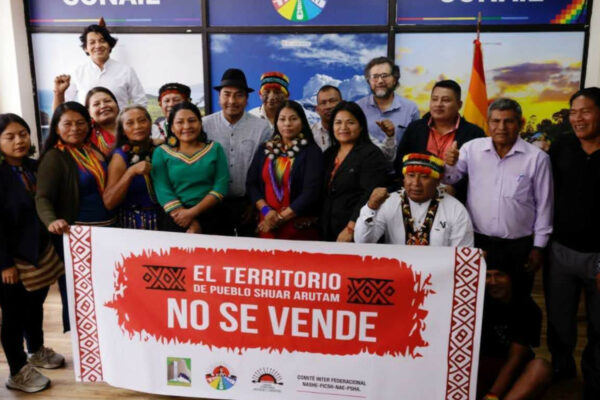
For the past decade, rates of deforestation in the Amazon have slowed to a comparative crawl. But researchers and environmentalists fear the pendulum might now be swinging in the opposite direction.
Brazil’s government says clearing in the Amazon slowed to the second-lowest level on record in 2014, with 1,871 square miles of forest lost in the past year. That’s down 18 percent from the 2,275 square miles lost in 2013 and a fraction of the over 10,400 square miles cut down in 2004 – the worst year on record.
But this year’s level is up from the low mark of 1,765 square miles in 2012, when Brazil’s government loosened land use restrictions in the Amazon. And environmental watchdogs say new monthly numbers indicate the rate of deforestation might be increasing rapidly this year.
“Brazil has been on a path of trying to bring down deforestation a lot,” Maira Irigaray, the Brazil program coordinator for Amazon Watch, told VICE News. “But when it comes to the Amazon, those numbers are still huge.”
Amazon Watch and other groups say Brazil’s decision to roll back laws limiting the clear cutting of forests been behind the rise in deforestation. Monthly numbers for November were “significantly” higher than last year, Irigaray said. “That’s definitely due to the change in the Forest Code here in Brazil and concessions for big development projects in the Amazon.”
In addition to being home to thousands of unique plant and animal species and nearly half a million indigenous people, the world’s largest rainforest is a natural sink for massive amounts of carbon dioxide. Trees absorb atmospheric carbon and store it in their mass. The more trees there are, the more carbon is pulled out of the atmosphere. Clearing forests, especially through slash and burn techniques, releases all that stored carbon dioxide back into the atmosphere, exacerbating climate change. Worldwide, tropical forests absorb about 20 percent of the world’s carbon emissions each year.
But nearly 290,000 square miles – just under 19 percent of the Amazon – has been cleared since 1988, the government estimates. Urban growth and mineral extraction are claiming a lot of forest land, the environment ministry reported, but about 60 percent of the lost forest has been to make way for livestock grazing.
“The biggest reason is cattle,” Irigaray told VICE News. “If you check the market for meat – the price changes in the market – then you see deforestation rates changing.”
President Dilma Rousseff vetoed some portions of the revised Forest Code in 2012 but allowed most of the new law to pass. It weakened rules on how much of the Amazon is protected, in what critics called a victory for agriculture and development interests.
The Brazilian government measures deforestation rates each year in August. But the Brazilian environmental group Imazon reported that 402 square kilometers of forest were wiped out in September, followed by another 244 in October. Those figures are up roughly fourfold from the same months in 2013.
Both the government and Imazon use satellite imagery to calculate forest cover loss. But Stephan Schwartzman, the head of the tropical forest program at the Environmental Defense Fund (EDF), told VICE News the monthly figures are calculated using lower-resolution satellite images than those used by government, so there’s no real conflict between the two numbers.
Nevertheless, he said, the monthly figures are something the government should be taking “very seriously.” The data was sensitive enough that the Rousseff government didn’t release its monthly numbers until after November’s elections, he said – a sign of how seriously the Brazilian public takes the issue.
“Obviously they are of some concern,” Schwartzman said. “But it’s hard to come to any broader conclusion based on two months of data.”
Iragaray said the Rousseff administration has a long list of development projects it wants to build in the Amazon, including a dam that would corral the last untamed tributary of the world’s second-longest river. That’s going to put more pressure on the Amazon Basin’s indigenous tribes, which have already seen forests on the borders of their protected lands sharply cut back.
“There’s some scientists in Brazil that say, for the environment and the indigenous population, the Rousseff government has been the worst government since the military dictatorship of the 1980s,” Iragaray told VICE News.
Schwartzman said Brazil is still on track to meet its goals for reducing carbon emissions 80 percent by 2020. But EDF warned this week that up to 20 percent of the Amazon’s tropical forests are at risk from logging, mining, agriculture, and other development.
Schwartzman told VICE News: “Brazil is still the world’s leading reducer of greenhouse gases because of what it’s done to control Amazon deforestation.”













